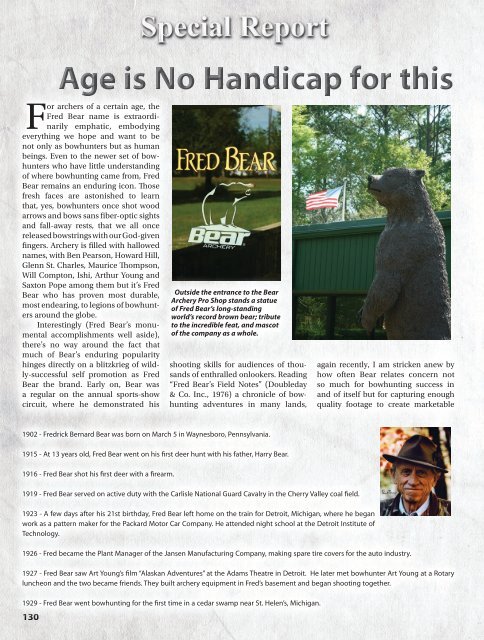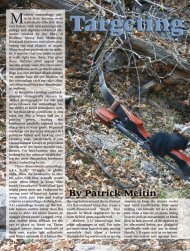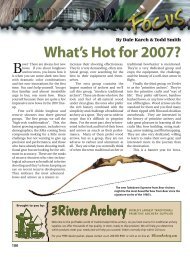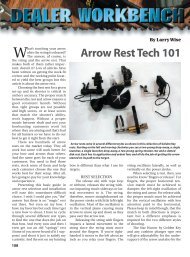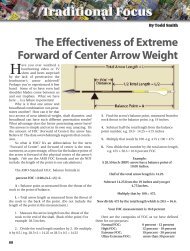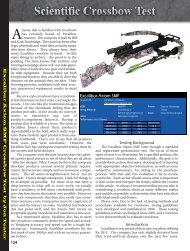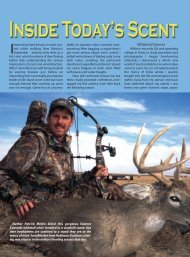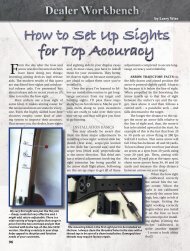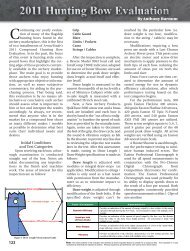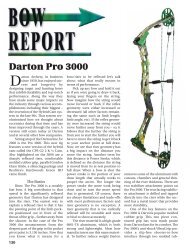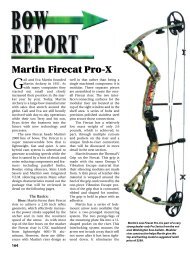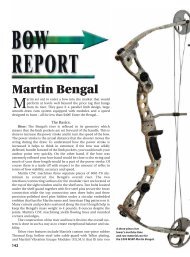Bear Archery Turns 80 - Arrow Trade Magazine!
Bear Archery Turns 80 - Arrow Trade Magazine!
Bear Archery Turns 80 - Arrow Trade Magazine!
Create successful ePaper yourself
Turn your PDF publications into a flip-book with our unique Google optimized e-Paper software.
Age is No Handicap for this<br />
For archers of a certain age, the<br />
Fred <strong>Bear</strong> name is extraordinarily<br />
emphatic, embodying<br />
everything we hope and want to be<br />
not only as bowhunters but as human<br />
beings. Even to the newer set of bowhunters<br />
who have little understanding<br />
of where bowhunting came from, Fred<br />
<strong>Bear</strong> remains an enduring icon. Those<br />
fresh faces are astonished to learn<br />
that, yes, bowhunters once shot wood<br />
arrows and bows sans fiber-optic sights<br />
and fall-away rests, that we all once<br />
released bowstrings with our God-given<br />
fingers. <strong>Archery</strong> is filled with hallowed<br />
names, with Ben Pearson, Howard Hill,<br />
Glenn St. Charles, Maurice Thompson,<br />
Will Compton, Ishi, Arthur Young and<br />
Saxton Pope among them but it’s Fred<br />
<strong>Bear</strong> who has proven most durable,<br />
most endearing, to legions of bowhunt-<br />
ers around the globe.<br />
Interestingly (Fred <strong>Bear</strong>’s monumental<br />
accomplishments well aside),<br />
there’s no way around the fact that<br />
much of <strong>Bear</strong>’s enduring popularity<br />
hinges directly on a blitzkrieg of wildly-successful<br />
self promotion as Fred<br />
<strong>Bear</strong> the brand. Early on, <strong>Bear</strong> was<br />
a regular on the annual sports-show<br />
circuit, where he demonstrated his<br />
Outside the entrance to the <strong>Bear</strong><br />
<strong>Archery</strong> Pro Shop stands a statue<br />
of Fred <strong>Bear</strong>’s long-standing<br />
world’s record brown bear; tribute<br />
to the incredible feat, and mascot<br />
of the company as a whole.<br />
shooting skills for audiences of thousands<br />
of enthralled onlookers. Reading<br />
“Fred <strong>Bear</strong>’s Field Notes” (Doubleday<br />
& Co. Inc., 1976) a chronicle of bowhunting<br />
adventures in many lands,<br />
again recently, I am stricken anew by<br />
how often <strong>Bear</strong> relates concern not<br />
so much for bowhunting success in<br />
and of itself but for capturing enough<br />
quality footage to create marketable<br />
1902 - Fredrick Bernard <strong>Bear</strong> was born on March 5 in Waynesboro, Pennsylvania.<br />
1915 - At 13 years old, Fred <strong>Bear</strong> went on his first deer hunt with his father, Harry <strong>Bear</strong>.<br />
1916 - Fred <strong>Bear</strong> shot his first deer with a firearm.<br />
1919 - Fred <strong>Bear</strong> served on active duty with the Carlisle National Guard Cavalry in the Cherry Valley coal field.<br />
1923 - A few days after his 21st birthday, Fred <strong>Bear</strong> left home on the train for Detroit, Michigan, where he began<br />
work as a pattern maker for the Packard Motor Car Company. He attended night school at the Detroit Institute of<br />
Technology.<br />
1926 - Fred became the Plant Manager of the Jansen Manufacturing Company, making spare tire covers for the auto industry.<br />
1927 - Fred <strong>Bear</strong> saw Art Young’s film “Alaskan Adventures” at the Adams Theatre in Detroit. He later met bowhunter Art Young at a Rotary<br />
luncheon and the two became friends. They built archery equipment in Fred’s basement and began shooting together.<br />
1929 - Fred <strong>Bear</strong> went bowhunting for the first time in a cedar swamp near St. Helen’s, Michigan.<br />
130
Famous Bow Manufacturer<br />
By Patrick Meitin<br />
and relaxation into stress and tedious<br />
toil. It’s all business, plain and simple.<br />
<strong>Bear</strong>’s first bowhunting films<br />
included a 1942 production by Jack<br />
Van Coevering, sports editor of the<br />
Detroit Free Press; 1946’s “Moose<br />
Diary,” based on a Canadian moose<br />
hunt conducted the year before and<br />
1951 and 1952 depictions of <strong>Bear</strong>’s<br />
first western bowhunts for mule deer,<br />
pronghorn and elk. These productions<br />
set the stage in making <strong>Bear</strong> <strong>Archery</strong><br />
films standard promotional material.<br />
The complete Fred <strong>Bear</strong> DVD collection<br />
was assembled and introduced<br />
in 2010, allowing enthusiasts to enjoy<br />
many of these early productions, as<br />
well as many other interesting Fred<br />
<strong>Bear</strong> moving-picture tidbits.<br />
Fred <strong>Bear</strong>’s first whitetail deer, taken in 1935, was a big event. Few believed bowhunting<br />
was a viable method of harvest in those days, so pioneers like <strong>Bear</strong> (lower right)<br />
were forced to find success with primitive equipment and sway an unbelieving public.<br />
“movies.” These sentiments and worries<br />
are woven intermittently into the<br />
very fabric of that seminal bowhunting<br />
book. I can attest from first-hand<br />
experience: filming hunts with even<br />
modern video equipment (as opposed<br />
to the temperamental film cameras of<br />
<strong>Bear</strong>’s time) is far from romantic labor.<br />
Filming takes away from the overall<br />
hunting experience and transforms fun<br />
The Big Picture<br />
Despite his relentless spin doctoring<br />
in direct relation to the company<br />
he piloted so skillfully, <strong>Bear</strong> managed<br />
never to lose sight of the big picture, of<br />
advancing the greater good, the idea of<br />
archery and bowhunting as something<br />
larger than himself. Fred <strong>Bear</strong> somehow<br />
managed to remain stalwartly free<br />
of today’s egocentric posturing, though<br />
if anyone had a right to engage in a bit<br />
of “the braggies” (as Ernest Hemingway<br />
1933 - Fred <strong>Bear</strong> and Charles Piper founded the <strong>Bear</strong> Products Company. Their primary products were silkscreened advertising materials. Off<br />
in a corner of the small building, Fred made archery equipment and it soon became a full time business.<br />
1934 - Fred <strong>Bear</strong> won the Michigan State Target Championship.<br />
1935 - Fred <strong>Bear</strong> shot his first deer with a bow and arrow.<br />
1937 - Fred <strong>Bear</strong> patents were granted for the modern shooting glove.<br />
1937, 1939 - Fred <strong>Bear</strong> won the Michigan Field <strong>Archery</strong> Championship.<br />
1942 - The first Fred <strong>Bear</strong> bowhunting film was produced with Jack Van Coevering.<br />
1943 - Fred <strong>Bear</strong> began work on his first takedown bow.<br />
1945 - Fred <strong>Bear</strong>’s first bow and arrow big game other than deer, a Canadian Moose, was taken.<br />
131
The three-piece Fred <strong>Bear</strong> Custom Takedown was Fred <strong>Bear</strong>’s own<br />
design and one of his favorite hunting bows and proudest accomplishments.<br />
The 1970 design remains much the same today, allowing<br />
nearly instant assembly without tools, limbs plugging into a grooveand<br />
stud-fit riser base and locked in place by hinged latches that<br />
secure the limb solidly.<br />
Despite being heavily involved in the evolution of the modern<br />
compound bow, Fred <strong>Bear</strong> couldn’t quite shake his traditional<br />
roots, sticking to the recurve bows and wood arrows he had<br />
become so accustomed to through his lifetime of bowhunting,<br />
put it), it would have been Fred <strong>Bear</strong>.<br />
(Kodiak II) in 1954, <strong>Bear</strong> Razorhead<br />
This is only part of the overall<br />
broadheads with replaceable bleeder<br />
allure of Fred <strong>Bear</strong> the man. There is<br />
blades in 1956, snap-on bow quiv-<br />
<strong>Bear</strong>’s humble personality, borne of<br />
ers in 1963, high-compression wood<br />
rural Pennsylvania beginnings. Even<br />
handle material in 1965, the tool-free-<br />
his later-years moniker “Papa <strong>Bear</strong>”<br />
assembled Takedown recurves in 1969,<br />
hints at a folksy, gentle demeanor;<br />
screw-in Converta Point arrows in 1968<br />
someone who puts people at ease, an<br />
and magnesium alloy bow handles in<br />
old friend, a man you could sit down<br />
1971. With friend Glenn St. Charles,<br />
to a relaxed chat with. From a manu-<br />
Fred <strong>Bear</strong> also helped pioneer the<br />
facturing standpoint, the innovations<br />
Pope & Young Club and was one of<br />
Fred <strong>Bear</strong> introduced to archery equip-<br />
the club’s first directors. In fact, Pope &<br />
ment would change the sport forever:<br />
Young’s first Awards Program was held<br />
for instance, patenting the first shoot-<br />
in Grayling, Michigan, as a direct result<br />
ing glove in 1937, fiberglass bow backing<br />
and the first bow quivers in 1946,<br />
The company Fred <strong>Bear</strong> (and part-<br />
written bow registration and warranty<br />
ner Charles Piper) founded in 1933<br />
in 1949, more reliable unidirectional<br />
eventually spawned some of the most<br />
fiberglass laminates and pneumatic<br />
popular bows the sport has ever wit-<br />
bow presses to speed production in<br />
nessed: the Grizzly (introduced 1949),<br />
1951, the first working recurve bows the Kodiak Magnum (1961), the of <strong>Bear</strong>’s involvement.<br />
Super<br />
Kodiak and Super Magnum (1967 ½),<br />
the 1970 Takedown and the 1973 Super<br />
Grizzly, just for some examples. A<br />
product of American archery’s infancy,<br />
<strong>Bear</strong> knew the times when bowhunters<br />
were forced to hand-hew their own<br />
equipment in order to participate in<br />
the sport, or pay dearly for hand-crafted<br />
bows made by a very few skilled<br />
bowyers across the country. He envisioned<br />
reliable and most of all affordable<br />
archery equipment produced for<br />
the masses. That dream began to take<br />
shape by the early 1950s, was made<br />
whole by the early 1960s and continued<br />
through the 1970s, a timeframe when<br />
<strong>Bear</strong> <strong>Archery</strong> came to all but dominate<br />
the traditional bow market.<br />
1946 - Fred <strong>Bear</strong>’s first black bear was taken.<br />
1946 - Fred <strong>Bear</strong> patented the use of fiberglass as bow backing.<br />
1946 - Fred <strong>Bear</strong> secured his first bow quiver patents.<br />
1946 - “Moose Diary,” Fred <strong>Bear</strong>’s second bowhunting film, was produced.<br />
1947 - The <strong>Bear</strong> <strong>Archery</strong> plant opened in Grayling, Michigan.<br />
1949 - <strong>Bear</strong> <strong>Archery</strong> bows carried a written registration and warranty for the first time.<br />
1949 - The <strong>Bear</strong> Grizzly bow was introduced.<br />
1951 - Fred <strong>Bear</strong> developed special presses for bow bonding.<br />
1951 - Unidirectional glass was developed and patented; for use as bow backing and facing.<br />
132
<strong>Bear</strong> <strong>Archery</strong> Products Operations Manager Neil Byce III compares a Super Kodiak<br />
bubinga handle section to the template used to assure risers remain within specs during<br />
production. The long tapers at each end assure a smooth transition into the recurve’s<br />
limbs.<br />
Shaping The Legend<br />
It’s interesting to note that despite<br />
today’s mythical status, Fred <strong>Bear</strong> did<br />
not make his mark overnight as a bowhunter<br />
or businessman. Born Fredrick<br />
Bernard <strong>Bear</strong> on March 5, 1902, <strong>Bear</strong><br />
enjoyed his first deer hunt in 1913, at<br />
age 13, while accompanying his father<br />
Harry <strong>Bear</strong> into the Pennsylvania<br />
woods. At age 14, <strong>Bear</strong> shot his first<br />
deer with a firearm. With the outbreak<br />
of World War I, <strong>Bear</strong> served on active<br />
duty with the Carlisle National Guard<br />
Cavalry, safeguarding Pennsylvania’s<br />
strategic Cherry Valley coal field. A few<br />
days after his 21st birthday in 1923,<br />
<strong>Bear</strong> took a train to Detroit, Michigan,<br />
where he quickly took a job as a pattern<br />
maker for the Packard Motor<br />
Car Company while also attending<br />
night school at the Detroit Institute of<br />
Technology, studying engineering. By<br />
1926, <strong>Bear</strong> became the plant supervisor<br />
of the Jansen Manufacturing Company,<br />
a company that created spare tire covers<br />
for the auto industry. All of this<br />
early manufacturing experience would<br />
shape latter approaches to the bow<br />
company he was destined to found.<br />
But it was the 1927 Arthur Young<br />
(of Pope & Young fame) film “Alaskan<br />
Adventures,” which <strong>Bear</strong> took in at<br />
Detroit’s Adam’s Theatre, that would<br />
forever alter his life path. <strong>Bear</strong> later met<br />
Art Young at a Rotary luncheon, where<br />
the two became fast friends, soon afterwards<br />
shooting and building archery<br />
equipment together in the basement<br />
of <strong>Bear</strong>’s home. <strong>Bear</strong> remained unable<br />
to bowhunt for his first time until 1929,<br />
when he stalked the cedar swamps<br />
near St. Helen’s, Michigan. In 1934,<br />
<strong>Bear</strong> won his first Michigan State Target<br />
133
Championship (a title he would earn<br />
again in 1937 and 1939) and the following<br />
year, he took his first deer with<br />
a bow and arrow near Blaney Park,<br />
Michigan, using a simple tie-on broadhead<br />
laced to a wood arrow with thin<br />
wire and a bow carved from an $8 Osage<br />
orange stave. Of course, by 1933, Fred<br />
<strong>Bear</strong> and Charles Piper had founded<br />
the <strong>Bear</strong> Products Company, providing<br />
silk-screening for advertising materials<br />
for the auto industry, <strong>Bear</strong> reserving<br />
a small corner of the cramped building<br />
to produce archery equipment.<br />
As interest in the sport grew, archery<br />
became a full-time business.<br />
The rise of <strong>Bear</strong> <strong>Archery</strong> to prominence<br />
did not come without trials<br />
and tribulations. <strong>Bear</strong> <strong>Archery</strong>, after<br />
all, emerged during the dark days of<br />
the Great Depression. I’ve watched<br />
video interviews of Fred <strong>Bear</strong> in his<br />
tranquil latter days, relating tales of<br />
hostile debt collectors at the door<br />
and near financial disasters, including<br />
one example caused by a chronic<br />
failure of aluminum-backed bows<br />
and a rash of warranty returns that<br />
the company in good faith made good<br />
on, even as it nearly went bankrupt.<br />
But <strong>Bear</strong> persevered, eventually buying<br />
his partner out and forging ahead<br />
stubbornly. In 1947, <strong>Bear</strong> moved the<br />
plant to the banks of the AuSable River<br />
near Grayling, Michigan, between the<br />
AuSable and Huron National Forests,<br />
1951 - Fred <strong>Bear</strong> had his first western bowhunt.<br />
having outgrown his Detroit building<br />
and wanting to be closer to his favorite<br />
hunting and fly-fishing territory. He<br />
lived with his new wife, Henrietta, in an<br />
unheated cabin during that first year of<br />
financial transition.<br />
He also continued to rack up firsts<br />
in his bowhunting career. Many are<br />
chronicled on film for all to enjoy,<br />
including a 1945 Canadian moose, a<br />
1946 black bear, a 1952 elk and pronghorn,<br />
a 1954 mule deer, a 1955 safari<br />
to French Equatorial Africa, a 1955<br />
western Canadian moose and mountain<br />
caribou, a 1957 British Columbian<br />
bowhunt resulting in his world record<br />
Stone sheep, a 1960 world record<br />
Alaskan Kodiak bear, a 1963 British<br />
Columbian grizzly hunt (featured in<br />
Life magazine) and Indian Bengal tiger,<br />
a 1964 elephant on a Mozambique<br />
safari with Author Godfrey, a 1965 lion<br />
and Cape buffalo (Mozambique) and<br />
polar bear (after three attempts) and a<br />
1967 Asiatic buffalo on Marajo Island,<br />
Brazil, just to offer highlights.<br />
Chairman <strong>Bear</strong><br />
From here, the trajectory of Fred<br />
<strong>Bear</strong>’s brainchild becomes less about<br />
the man himself and more about the<br />
company bearing his name, though<br />
throughout the several sales and transitions<br />
to come, Fred <strong>Bear</strong> retained<br />
the president and chairman seats until<br />
his death in April, 27, 1988 at age 86.<br />
<strong>Bear</strong> sold his hugely-successful archery<br />
company to the Victor Comptometer<br />
Corporation in 1968. Many ask the<br />
obvious question of why but they<br />
should recall that <strong>Bear</strong> was by then 66<br />
years old. He wished to raise money<br />
to further his promotion of archery<br />
and bowhunting to the masses. The<br />
sale also gave <strong>Bear</strong> time to concentrate<br />
on what he loved most: researching<br />
and developing new bow models. His<br />
offices invariably included an alcove<br />
with a complete shop, where he often<br />
tinkered on new designs through the<br />
day. Despite the sale to the Victor<br />
Comptometer Corporation (and then<br />
Walter Kidde in 1976), most of the <strong>Bear</strong><br />
<strong>Archery</strong> traditional classics in production<br />
today were conceived and initially<br />
produced during those years.<br />
By 1978, <strong>Bear</strong> <strong>Archery</strong> had outgrown<br />
its Grayling, Michigan facility.<br />
<strong>Bear</strong> was 76 and Michigan’s winters<br />
were becoming less tolerable. Unioninspired<br />
strikes and labor disputes provided<br />
the final push out of Michigan.<br />
After considering several locations<br />
across the nation, <strong>Bear</strong> <strong>Archery</strong> moved<br />
to Archer Road (named after the town<br />
of Archer) in Gainesville, Florida, where<br />
the facility is located to this day. There,<br />
<strong>Bear</strong> was able to enjoy a climate friendlier<br />
to his worsening emphysema (in<br />
his later years, he was forced to tote an<br />
oxygen bottle everywhere he went) and<br />
hunt and fish nearly year round. The<br />
1952 - Fred <strong>Bear</strong>’s first elk and first antelope was taken in Wyoming.<br />
1954 - <strong>Bear</strong> <strong>Archery</strong> produced the first working recurve bows (Kodiak II).<br />
1954 - Fred <strong>Bear</strong> had his first successful western mule deer hunt.<br />
1955 - Fred <strong>Bear</strong> had his first overseas hunt in French Equatorial Africa.<br />
1955 - Fred <strong>Bear</strong> had his first western Canada hunt for moose and caribou.<br />
1956 - <strong>Bear</strong> <strong>Archery</strong> marketed new <strong>Bear</strong> Razorhead hunting points.<br />
1957 - Fred <strong>Bear</strong> took his world record Stone sheep in British Colombia.<br />
1958 - Pope and Young’s first Awards Program was held in Grayling.<br />
1960 - Fred <strong>Bear</strong> took his world record Kodiak bear in Alaska.<br />
1960 - <strong>Bear</strong> <strong>Archery</strong> developed clear “Crystalight” <strong>Bear</strong>glass.<br />
134
compound bow had begun to make<br />
its mark, slowly eroding the traditional<br />
models’ hold on the sport. <strong>Bear</strong> adapted<br />
and rode the new trend with models<br />
such as the heralded Whitetail Hunter,<br />
never speaking badly of the compound<br />
bow as many seem to believe. After a<br />
lifetime of shooting traditional bows,<br />
he found the let-off from compound<br />
bows distracting to his fluid, instinctive<br />
shooting style, so he never completely<br />
got the knack of shooting them, preferring<br />
his standby Takedown recurve to<br />
the very end. Otherwise, <strong>Bear</strong> was right<br />
in the middle of the compound bow<br />
revolution, even purchasing Jennings<br />
<strong>Archery</strong> in 1983.<br />
An early aerial view of the large <strong>Bear</strong> <strong>Archery</strong> plant in Gainesville,Florida.<br />
New Beginnings<br />
A succession of company owners<br />
followed: Hanson Industries (19<strong>80</strong>s),<br />
U.S. Industries (1994), Fenway Partners<br />
(1995) and finally Charles Palmer’s 1999<br />
takeover under the North American<br />
<strong>Archery</strong> Group umbrella, including<br />
Golden Eagle, Satellite, Jennings<br />
and <strong>Bear</strong>. During the early 1990s, the<br />
compound bow had taken over as the<br />
weapon of choice among the majority<br />
of bowhunters and <strong>Bear</strong> <strong>Archery</strong><br />
remained at the forefront of tion. <strong>Bear</strong> <strong>Archery</strong> sponsored nearly<br />
innova-<br />
all the best shooters of the time, many<br />
tournament seasons having all the top<br />
winners shooting <strong>Bear</strong> bows. But without<br />
Fred <strong>Bear</strong>, by all accounts a handson<br />
man with uncompromising standards,<br />
to keep things on track, by the<br />
late 1990s, the once-legendary name<br />
faltered under lack of direction and<br />
most especially technological innovation,<br />
the traditional bow line on which<br />
the company was founded figuratively<br />
dying on the vine. By the early 2000s,<br />
the brand was in danger of fading away,<br />
the Fred <strong>Bear</strong> name alone not enough<br />
to prop up lackluster products.<br />
In June 2003, Escalade Sports, a<br />
large sporting goods conglomerate<br />
headquartered in Evansville, Indiana,<br />
purchased the North American <strong>Archery</strong><br />
Group out of bankruptcy. In a community<br />
as intimate as the archery industry,<br />
the rumor mill was bound to kick in.<br />
Some gossip, I can relate from personal<br />
observations; some said Escalade’s<br />
new archery division was given three<br />
years to sink or swim. If management<br />
couldn’t make it fly in that time, it<br />
would be allowed to die. Some said<br />
that before purchasing the company,<br />
Escalade sold nothing but ping-pong<br />
tables (they do, in fact, own a division<br />
selling such wares) and didn’t know<br />
bows from basketballs. Perhaps the<br />
biggest stretch was that <strong>Bear</strong> products<br />
would thereafter be made overseas.<br />
Gossip is rarely based in reality.<br />
One is left to wonder how these things<br />
get started. The essential truth was that<br />
Escalade invested millions of dollars<br />
in basic infrastructure before it could<br />
ship its first bow. The 156,000 square<br />
foot Gainesville manufacturing facility<br />
needed a new roof and the air-conditioning<br />
units and CNC machines occupying<br />
the building since its construction<br />
in 1978 required replacements<br />
and rebuilding. It was hardly a viable<br />
business plan for a company applying<br />
a sink-or-swim approach. In regards<br />
135
to Escalade’s previous involvement in<br />
archery, they in fact have roots in the<br />
industry dating back to 1927, as Indian<br />
<strong>Archery</strong> & Toy Company, the oldest<br />
archery company in the United States.<br />
You might remember them more<br />
recently as Indian Xi, which sponsored<br />
archery luminaries such as Miles Keller<br />
and Larry Wise. Most importantly, all<br />
<strong>Bear</strong> <strong>Archery</strong> Products bows are still<br />
made right here in the USA, more specifically<br />
in Gainesville, Florida.<br />
The Midas Touch<br />
Escalade’s <strong>Bear</strong> <strong>Archery</strong> Products<br />
division is staffed by a multitude<br />
of hard-core archery enthusiasts.<br />
Company employees Ross Rinehart<br />
(International Sales Manager), Jeff<br />
Pease (National Sales Manager), Jack<br />
Bowman (President), Josh Sidebottom<br />
(Engineering Manager), Jason Pickerill<br />
(Marketing Manager), Steve Dalp<br />
(Product Manager) and Neil Byce<br />
(Director of Operations, Gainesville,<br />
Florida), for example, have extensive<br />
experience in the archery industry and<br />
an underlying passion for bowhunting.<br />
Escalade CEO Bob Keller developed an<br />
interest in bowhunting after exposure<br />
to his <strong>Bear</strong> <strong>Archery</strong> crew and is now a<br />
fervent archer and bowhunter himself.<br />
In a very short time, <strong>Bear</strong> <strong>Archery</strong><br />
Products, under Escalade’s guidance,<br />
became a force to be reckoned with. As<br />
Marketing Manager Jason Pickerill put<br />
it to me recently, “A company that has<br />
something to prove is dangerous.” It’s<br />
fair to say this transformation, some<br />
might say emergence from the flames,<br />
<strong>Bear</strong>’s fast new Motive 6 is at left, while the 2013 Domain is shown at right in a RTH or<br />
Ready To Hunt version.<br />
began with the Truth line. Since that<br />
year, 2006, <strong>Bear</strong> <strong>Archery</strong> wares have<br />
become increasingly innovative with<br />
each successive season. Today, <strong>Bear</strong><br />
compounds are once again among<br />
the most cutting edge and hardesthitting<br />
in the industry. The traditional<br />
line, through concerted effort by <strong>Bear</strong><br />
1961 - <strong>Bear</strong> <strong>Archery</strong> introduced the Kodiak Magnum bow.<br />
1963 - <strong>Bear</strong> <strong>Archery</strong> introduced snap-on bow quivers.<br />
1963 - The Fred <strong>Bear</strong> grizzly hunt in British Columbia was featured in Life magazine.<br />
1963 - Fred <strong>Bear</strong> took a Bengal Tiger in India.<br />
1964 - <strong>Bear</strong> <strong>Archery</strong>’s Two Season Hunter advertising theme began.<br />
1964 - Fred <strong>Bear</strong> took an elephant on an African safari with Arthur Godfrey.<br />
1965 - Fred <strong>Bear</strong> had his third African safari for Lion and Cape buffalo.<br />
1965 - <strong>Bear</strong> <strong>Archery</strong> introduced high compression handle material.<br />
1965 - Fred <strong>Bear</strong> took a polar bear on his third try.<br />
136
<strong>Archery</strong> Products management, has<br />
quickly regained its place as a singlestring<br />
touchstone, appealing to both<br />
long-time traditionalists and new converts<br />
who only wish to expand their<br />
enjoyment of archery in addition to the<br />
compounds they regularly wield.<br />
The Charging <strong>Bear</strong><br />
Reaching back 12 quarters, the<br />
<strong>Bear</strong> <strong>Archery</strong> Products compound<br />
line began to gain momentum and<br />
grab headlines with models such as<br />
the Attack (2010), the Carnage (2011)<br />
and the Anarchy (2012). Important<br />
advances included milled aluminum<br />
risers taking on more aesthetically<br />
pleasing lines and shedding mass (all<br />
models today weighing about or less<br />
than 4 pounds), Max Pre-Load Quad<br />
Limbs providing faster and quieter<br />
past-parallel geometry, Zero-Tolerance<br />
Limb Pockets providing more accuracy<br />
and silence, Dual Arc Offset String<br />
Suppressors providing more positive<br />
nock separation on release and quieter<br />
shots without speed-robbing string<br />
silencers, and 4x4 Roller Guards for<br />
additional buss-cable control and wear<br />
elimination, just to name a few.<br />
Cam systems have evolved with<br />
each new season as well; last year’s<br />
Flat Top Cam and <strong>Bear</strong> Skeleton Cam<br />
systems (both single cam systems)<br />
are perfect examples of the forwardthinking<br />
technology prevailing with<br />
<strong>Bear</strong> <strong>Archery</strong> Products’ engineers. The<br />
<strong>80</strong> percent let-off Flat Top -- powering<br />
the forgiving 35.25-inch, 7.25-inch<br />
braced Anarchy retained in this year’s<br />
lineup -- rockets arrows to IBO speeds<br />
of 330 fps without the challenging draw<br />
cycles normally associated with flagship<br />
speed bows. In fact, the Anarchy<br />
was one of the smoothest, most forgiving<br />
compounds I shot last year. I can<br />
say the same of the 2011 Carnage (held<br />
over in this year’s lineup), a 32-inch,<br />
7.25-inch braced dynamo that propelled<br />
arrows to 345 fps while retaining<br />
a silky draw cycle. The latest <strong>Bear</strong><br />
compounds retain these solid selling<br />
points while featuring progressive performance<br />
features worn by some of the<br />
biggest names in the industry.<br />
The big news for 2013 revolves<br />
around three new cam systems. <strong>Bear</strong><br />
<strong>Archery</strong> has entered the hybrid cam<br />
market with the all-new H13-Cam,<br />
at the same time refining the singlecam<br />
market with the new S13-Cam<br />
and E3-Cam designs. The H13-Cam<br />
is found on three 2013 models: the<br />
flagship Motive 6 and 7 and the lowerpriced<br />
Method. The S13-Cam is offered<br />
on the Empire and the E3-Cam on the<br />
more affordable Domain. Essentially,<br />
the Motive and Empire bows are the<br />
same designs as the Method and<br />
Domain, only with different cam systems<br />
on each, hybrid or single cam, as<br />
per customer desires.<br />
All-New <strong>Bear</strong> Compounds!<br />
The Motive 6 includes 350 fps<br />
IBO speeds, a 4-pound mass, a 6-inch<br />
brace and 32-inch axle-to-axle dimension<br />
powered by a H13-Cam system<br />
equipped with dual stainless steel<br />
sealed bearings, the riser holding the<br />
4x4 Roller Guard system. The Motive 7<br />
is much the same but includes a more<br />
forgiving 7-inch brace and 340 fps IBO<br />
speeds. Both Motives include an MSRP<br />
of $900.<br />
The Empire is essentially the<br />
S13-Cam (single-cam) version of the<br />
Motive 7, including identical specs<br />
and dimensions,<br />
but has 330 fps IBO<br />
arrow speeds and a<br />
lower $850 MSRP.<br />
Each of these models<br />
also includes<br />
an improved<br />
Adjustable Offset<br />
String Suppressor<br />
system for more<br />
tuning control.<br />
The $900<br />
MSRP, 3.8-pound<br />
Anarchy, offered<br />
again this year by<br />
popular demand,<br />
remains the same,<br />
including a 330<br />
fps IBO rating and<br />
the most forgiving<br />
specs in the<br />
entire <strong>Bear</strong> <strong>Archery</strong><br />
Products lineup,<br />
ideal for western<br />
hunters in the<br />
habit of stretching<br />
shooting range to<br />
the limit and looking<br />
for maximum<br />
accuracy potential<br />
or for those with exceptionally long<br />
draw lengths.<br />
The Method (the <strong>Bear</strong> bow I chose<br />
for the coming year) uses the company’s<br />
H13-Cam Hybrid system but gives<br />
the shooter a tad more forgiveness in a<br />
33-inch axle-to-axle length and 6.75-<br />
inch brace height, spitting arrows to<br />
an impressive 340 fps IBO. My test bow<br />
tuned instantly, is silky-smooth during<br />
the draw cycle, promotes proper<br />
back-tension shooting form (owning a<br />
solid back wall and shallow letoff valley)<br />
and delivers arrows with amazing<br />
authority. It holds a carbon cable slide<br />
instead of the Roller Guard and retails<br />
for a reasonable $650 MSRP.<br />
Finally, the new Domain is essentially<br />
the same as the Method but holds<br />
an S3-Cam single-cam power system<br />
instead of the new Hybrid cam. It<br />
includes a slightly higher 7-inch brace<br />
and a slightly slower 322 fps IBO rating;<br />
but also an MSRP of only $600.<br />
The added forgiveness is free of charge.<br />
Both of these bows represent great bargains<br />
for customers who want to experience<br />
flat-out performance but also<br />
have enough cash left over for arrows<br />
Reen Steenkamp<br />
editor@africanarcher.com<br />
137
and broadheads.<br />
There are also six budget-priced<br />
and youth/women bows in the 2013<br />
lineup. The Legion offers 318 fps IBO<br />
speeds in a 30.5-inch, 7-inch braced<br />
bow with an MSRP sticker price of only<br />
$400. The Encounter and Outbreak<br />
have an MSRP of only $300, the former<br />
30.5 inches long with a 7.75-inch brace<br />
and 310 fps IBO speed and the latter<br />
measuring 29.25 inches axle-to-axle,<br />
including a 7.25-inch brace and 308 fps<br />
advertised IBO speeds. The Siren is a<br />
top-grade compound made for serious<br />
women archers, measuring a compact<br />
31 inches with a 6.75-inch brace, 300<br />
fps arrow speeds, a 27-inch draw length<br />
and a 60 pound draw weight. It retails<br />
for around $600. The Home Wrecker’s<br />
a more affordable women’s option,<br />
with a $400 MSRP, a 28-inch overall<br />
length, a 7.25-inch brace and a 2<strong>80</strong> fps<br />
speed rating. Finally, the Apprentice<br />
2 was designed to give youth shooters<br />
enhanced performance, using a<br />
27.5-inch, 6.125-inch braced platform<br />
to push arrows to 265 fps. Its MSRP is<br />
only $2<strong>80</strong>.<br />
Regaining Traditional<br />
Supremacy<br />
In 2011, <strong>Bear</strong> <strong>Archery</strong> Products<br />
began an all-out attack to recapture<br />
the traditional marketplace it once all<br />
but dominated. An ingenious business<br />
plan resulted in an incredible 70<br />
percent growth in the traditional sion in a single year (as compared to<br />
2010). This started with more than divi-<br />
a<br />
year spent seeking detailed input<br />
from dealers and customers, the<br />
consensus, according to Director of<br />
Operations Neil Byce III (a 30-plus<br />
year <strong>Bear</strong> employee), being that <strong>Bear</strong><br />
should return to the look, feel, shootability<br />
and quality that made ‘60s and<br />
‘70s models great. This initiated the<br />
return of several <strong>Bear</strong> classics from<br />
yesteryear (some holding “Grayling<br />
Green” glass) and a couple all-new<br />
models, including the AuSable longbow<br />
as well as the reintroduction of<br />
the famed Fred <strong>Bear</strong> Master Shooting<br />
Glove. This push included a traditional-only<br />
catalog for the first time<br />
since the appearance of compound<br />
bows.<br />
Last year, several more traditional<br />
models were introduced, including<br />
the 64-inch, exotic African bubingahandled<br />
Super Kodiak models (MSRP<br />
$619) and the 64-inch, B-Riser, #3<br />
limbed Takedowns (MSRP $819). The<br />
revolutionary Fred <strong>Bear</strong> Takedown<br />
was also offered with gorgeous bubinga<br />
risers and limb fadeouts in 56-,<br />
60- and 64-inch models. Demand<br />
for all <strong>Bear</strong> traditional models has<br />
been so great, 14 new employees<br />
were hired to help keep abreast of<br />
demand.<br />
The big surprise for 2013 is that<br />
hard-core traditional shooters can<br />
look forward to the reintroduced<br />
The riser from the Fred <strong>Bear</strong> Takedown<br />
is shown at near right while next to it is<br />
the 2013 version of the Kodiak, which<br />
can use Fast Flight strings.<br />
1967 - The Fred <strong>Bear</strong> Museum opened in Grayling, Michigan.<br />
1967 - Fred <strong>Bear</strong> perfected his famous Takedown bow.<br />
1967 - After 17 years, the Kodiak bow ceased production.<br />
1967 - <strong>Bear</strong> <strong>Archery</strong> introduced the Super Kodiak & the 48 inch Super Magnum.<br />
1967 - Fred <strong>Bear</strong> hunted Asian buffalo on Marajo Island, Brazil.<br />
1968 - <strong>Bear</strong> <strong>Archery</strong> introduced Converta Point arrows.<br />
1968 - <strong>Bear</strong> <strong>Archery</strong> was sold to the Victor Comptometer Corp. Fred <strong>Bear</strong> remained President.<br />
1968 - “The Archer’s Bible,” the first of Fred <strong>Bear</strong>’s books, was published.<br />
1970 - <strong>Bear</strong> <strong>Archery</strong> introduced the Takedown.<br />
1971 - The introduction of magnesium alloy handles for takedowns.<br />
138
Carotid arteries (jugulars)<br />
Lungs are about two<br />
inches above lower<br />
body line to about 6<br />
inches from top of<br />
body. Aim close to<br />
center of animal.<br />
Heart lies between<br />
and slightly ahead<br />
of lungs, very low<br />
in body<br />
Carotids lie on<br />
both sides of<br />
windpipe just<br />
below spine.<br />
Lungs nearly<br />
protected by<br />
shoulder, extend<br />
behind it slightly.<br />
Lung shot deer<br />
runs fast at first.<br />
Heart is low and<br />
usually protected<br />
by leg.<br />
4<br />
Better chance at<br />
femoral than from<br />
side.<br />
Rear shot can cut<br />
aortic artery, other<br />
veins puncture<br />
heart or lungs<br />
Femoral artery is slightly<br />
inside leg bone.<br />
Spine hits drop Kidney shot<br />
animal immediately. bleeds heavily and<br />
Hits between kidney usually right away.<br />
and spine sever Animal may make<br />
aortic artery. a few jumps then<br />
walk away.<br />
Liver is<br />
just behind<br />
diaphragm<br />
on right side<br />
and angles<br />
toward<br />
body cavity.<br />
1972 - The Fred <strong>Bear</strong> Sports Club was opened to the public.<br />
1973 - The Super Grizzly was introduced.<br />
Kodiak, which is modeled after the<br />
1959 Kodiak but constructed of modern<br />
materials to make it Fast-Flight<br />
compatible so the latest string materials<br />
can be used. It retains the look and<br />
feel of the iconic recurve Fred <strong>Bear</strong><br />
used to bag many of his most important<br />
trophies, including I-Beam construction<br />
of Purple Heart and Bolivian<br />
rosewood, original brown- and caramel-hued<br />
glass, a feather rest and a<br />
leather grip. This elegant 60 inch bow<br />
will retail for a suggested $6<strong>80</strong>.<br />
In all, there are now 14 recurve<br />
and longbow models (22 counting<br />
length variations) included in the traditional<br />
lineup. On the short end, there<br />
is the Kodiak Magnum (MSRP $469),<br />
the quick-handling, 52-inch dynamo<br />
offered as one of the first “brush bows”<br />
in the industry. The longest one-piece<br />
recurve is the Super Kodiak, including<br />
the Grayling Green Super Kodiak in 60-<br />
and 64-inch models, with a gorgeous<br />
three-piece bubinga handle fashioned<br />
using an original 1967-1/2 model as<br />
a template but built using more fastflight<br />
compatible materials. Sturdy<br />
Dymond Wood, an epoxy-impregnated<br />
Check out AT’s FREE<br />
maple dyed various hues and laminated<br />
to create a material adding stability<br />
how-to video series<br />
for new shooters!!<br />
and aesthetic appeal to many of the<br />
traditional models, is now part of many<br />
of said models. The standard Super<br />
Kodiak ($519) includes a two-tone<br />
Get Answers Free at<br />
handle made of this durable material. <strong>Archery</strong>Talk.com<br />
The newly-refined three-piece • Over 25 million hits per month.<br />
Strung and unstrung images of the<br />
AuSable longbow from <strong>Bear</strong> <strong>Archery</strong>.<br />
The largest FREE<br />
archery classifieds<br />
on the internet!<br />
•Worlds largest archery website.<br />
•Sponsored by over 200<br />
manufacturers.<br />
•Talk to fellow archers, pros,<br />
and bowhunters worldwide.<br />
New Pocket Field Log<br />
Field Log<br />
1976 - Fred <strong>Bear</strong>’s second book, “Fred <strong>Bear</strong> Field Notes,” was published.<br />
1977 - Walter Kidde & Co. took over the Victor Comptometer Corp and <strong>Bear</strong> <strong>Archery</strong>.<br />
1978 - <strong>Bear</strong> <strong>Archery</strong> introduced the Super Razorhead.<br />
1978 - The <strong>Bear</strong> <strong>Archery</strong> plant moved to Gainesville, Florida.<br />
1979 - Fred <strong>Bear</strong>’s third book, “Fred <strong>Bear</strong>’s World of <strong>Archery</strong>,” was published.<br />
19<strong>80</strong> - The Fred <strong>Bear</strong> Signature Bow was announced.<br />
1981 - <strong>Bear</strong> <strong>Archery</strong> introduced stainless steel Razorheads.<br />
49 Pages filled with<br />
•Full grids for tracking or scout outings<br />
•Check list for the trip<br />
•Vital kill area<br />
•Information for Land Owner records<br />
See more at <strong>Archery</strong>talk.com<br />
139
Takedown also includes epoxy-impregnated<br />
maple riser construction, with a<br />
charcoal hue and red accent strip and<br />
limb tips. It’s now designed around a<br />
more substantial grip closely mirroring<br />
original ’69 models but still offers instant<br />
assembly, an inlaid working compass<br />
and Fascor limb cores (impregnated<br />
maple that offers additional performance).<br />
Recurve lengths of 56, 60<br />
and 64 inches are possible through A<br />
Riser/#1 Limbs and A Riser/#3 Limbs<br />
or B Riser/#1 Limbs, and B Riser/#3<br />
Limbs, respectively. Of course, the<br />
bubinga versions (already touched on)<br />
are also now included. From a personal<br />
perspective, I’ve bowhunted success-<br />
fully over the years with a good number<br />
of Fred <strong>Bear</strong> Takedowns and the<br />
newest incarnations are smoother and<br />
Trophy Ridge React sights are quick to set up thanks to a variable pitch lead screw that<br />
adjusts pins.<br />
sweeter shooting than ever, something affordably-priced Grizzly (MSRP<br />
more pointed when subjected to my<br />
extra-long draw length.<br />
$339), the reintroduced 58-inch Super<br />
Grizzly ($449) with a riser accent stripe<br />
Also look for the 58-inch, and Fast-Flight compatibility, the<br />
1983 - <strong>Bear</strong> <strong>Archery</strong> celebrated its 50th anniversary.<br />
1988 - Fred <strong>Bear</strong> passed away on April 27th.<br />
1995 - Hanson Industries sold <strong>Bear</strong> <strong>Archery</strong> to U.S. Industries.<br />
1997 - Fenway Partners acquired <strong>Bear</strong> <strong>Archery</strong> from U.S. Industries.<br />
1998 - <strong>Bear</strong> <strong>Archery</strong> introduced the Montana Long Bow.<br />
1999 - Charles Palmer purchased <strong>Bear</strong> <strong>Archery</strong> and renamed it North American <strong>Archery</strong> Group.<br />
2002 - <strong>Bear</strong> <strong>Archery</strong> teamed with legendary archer Byron Ferguson to promote the sport of traditional archery.<br />
2002 - The Royal Safari and Patriot longbows were introduced.<br />
2003 - In June, Escalade Sports purchased all of the assets of North American <strong>Archery</strong> Group of which the brand <strong>Bear</strong> <strong>Archery</strong> was a part.<br />
2006 - <strong>Bear</strong> <strong>Archery</strong> introduced the Supreme series of bows using exotic woods.<br />
2010 - The complete Fred <strong>Bear</strong> DVD collection was introduced.<br />
2011 - The 50 Year Anniversary version of the Kodiak Magnum was offered.<br />
2011 - <strong>Bear</strong> <strong>Archery</strong> brought back the Super Grizzly.<br />
2011 - Both A and B Riser Takedowns were brought back with a new look.<br />
2011 - The AuSable Long Bow was introduced.<br />
2011 - Grayling Green Glass used in the Kodiak Magnum & a new classic version of the Super Kodiak.<br />
2011 - The Fred <strong>Bear</strong> Master Shooting Glove was brought back.<br />
2012 - Two versions of the famous Take-Down bow were introduced.<br />
2013 - <strong>Bear</strong> <strong>Archery</strong> introduced a new Kodiak bow modeled after the famous 1959 Kodiak.<br />
140
super-short SuperMag 48 ($379), the<br />
56-inch performance-driven Cheyenne<br />
($489) and youth Kodiak Cub ($200)<br />
recurves, the Byron Ferguson-inspired<br />
Patriot Longbow ($519), the affordable<br />
and no-nonsense Montana Longbow<br />
($339) and the hard-shooting and gorgeous<br />
AuSable Longbow ($569) with<br />
reflex limbs and a semi-pistol grip.<br />
To own a modern <strong>Bear</strong> <strong>Archery</strong> traditional<br />
bow is to own a piece of history.<br />
Each is still made almost entirely by<br />
hand, just like in Fred <strong>Bear</strong>’s day, using<br />
the very presses designed and crafted<br />
by Papa <strong>Bear</strong> himself and brought from<br />
Grayling, Michigan. In the end, there’s<br />
really little difference in a production<br />
<strong>Bear</strong> recurve or longbow and a fully<br />
customized bow except that all materials<br />
and lines remain the same for the<br />
sake of streamlining production and<br />
bringing down costs. All shaping, tillering<br />
and finishing involves hand files,<br />
sandpaper and elbow grease, much of<br />
this conducted by employees who have<br />
been with the company for more than<br />
30 years.<br />
<strong>Bear</strong> Sister Companies<br />
Of course, Escalade also acquired<br />
Trophy Ridge, maker of top-grade<br />
archery accessories, and Rocket<br />
Broadheads, pioneer in mechanical<br />
broadhead technology since the takeover<br />
of <strong>Bear</strong> <strong>Archery</strong>. Recent developments<br />
at Trophy Ridge include<br />
Ballistix CoPolymer System material,<br />
giving accessories the strength<br />
of aluminum but with 40 percent less<br />
weight. This revolutionary technology<br />
is found in a growing number of<br />
Trophy Ridge accessories, including<br />
last year’s Cypher-series sights, Beacon<br />
and Threat Quivers and new-for-2013<br />
React Sights, Torsion Quivers and Static<br />
Stabilizers.<br />
The React Sight should prove a<br />
huge seller in the coming year, allowing<br />
customers to confidently dial in<br />
equipment faster and easier without<br />
second guessing whether poor shooting<br />
form is influencing long-range<br />
settings. The React includes a system<br />
by which the 20-yard pin is sighted,<br />
the Smart Pin Technology dial adjusted<br />
so the 30-yard pin is dead nuts<br />
from the correlating distance and the<br />
remaining three .019-inch diameter<br />
fiber-optic pins (40 to 60 yards) are<br />
automatically ready to roll. The allnew<br />
Torsion Quiver also includes<br />
Ballistix CoPolymer Technology construction,<br />
making it feather light and<br />
super compact. The four-arrow design<br />
is engineered to include a huge degree<br />
of vertical adjustment to help create<br />
perfect bow balance, the dual arrow<br />
grippers and round profile creating a<br />
secure but compact overall footprint.<br />
Also introduced for 2013, the Static<br />
Stabilizer, in 6- and 9-inch models,<br />
includes a “twisted-vine” profile holding<br />
mid-point dampening weights suspended<br />
in rubber “stars,” customizable<br />
cap weights and a rubber dampener.<br />
The lightweight design pulls unwanted<br />
vibrations and noise from any bow,<br />
the open-frame design allowing air to<br />
pass through for less buffeting in windy<br />
conditions. A braided-cord wrist sling<br />
and milled-aluminum base plate are<br />
included.<br />
The Rocket Broadhead line<br />
includes many battle-proven designs,<br />
one fixed, five mechanical and one<br />
fixed/mechanical combination, all<br />
now including Titanium Nitride (Ti-N)<br />
coating to make them even more reliable.<br />
Newer to the line are four Meat<br />
Seeker 1-1/2- to 2-inch wide models,<br />
including the Piston Hammer, with<br />
rear-deploying deployment that wastes<br />
no energy while opening, the rotating<br />
chisel tip rolling around bone and<br />
allowing it to take the path of least<br />
resistance for increased penetration.<br />
And this was just announced as I<br />
worked on this article: <strong>Bear</strong> <strong>Archery</strong><br />
has acquired the bowfishing assets<br />
and brand name of Cajun <strong>Archery</strong>.<br />
Originally founded in 1963 by William<br />
“Billy” Amentor, Cajun <strong>Archery</strong>’s initial<br />
focus consisted of hardwood and cedar<br />
arrows. By the 1970s, the company<br />
diversified, purchasing the rights to the<br />
original Sting-A-Ree bowhunting point<br />
in 1976 and eventually branching into<br />
other areas of bowfishing and general<br />
archery wares. In 2004, Cajun <strong>Archery</strong><br />
was purchased by David White of<br />
Corolla Capital Management, LLC (Hot<br />
Shot Releases, Aborigine Blowguns and<br />
the Plucker and Tusker product lines<br />
are also housed under this company<br />
umbrella). President Jack Bowman says<br />
<strong>Bear</strong> <strong>Archery</strong> has been eyeing the bowfishing<br />
market for some time and he is<br />
excited about the prospects of growing<br />
Cajun <strong>Archery</strong>’s bowfishing products<br />
and making it a leader in that popular<br />
segment of the industry. Cajun’s<br />
headquarters will move to Evansville,<br />
Indiana and its manufacturing to<br />
Gainesville, Florida. Hot Shot Releases,<br />
Aborigine Blowguns, the Plucker and<br />
Tusker product lines and production<br />
of Cajun’s arrow line will remain in<br />
Logan, Utah, under the control of Dave<br />
White.<br />
The new <strong>Bear</strong> <strong>Archery</strong> Products<br />
business approach has been to listen<br />
carefully to customers and dealers,<br />
not deciding what customers want to<br />
shoot, but allowing customers to say<br />
what they will be willing to spend their<br />
hard-earned money on. The results<br />
speak for themselves: hard-working<br />
bows and accessories offered at competitive<br />
prices that meet or exceed the<br />
performance capabilities of anything<br />
on the marketplace. It’s something I<br />
think Fred <strong>Bear</strong> would be happy to put<br />
his name on.<br />
Harness the power of the world-wide-web to bring new customers to your door.<br />
Increase Your Sales<br />
Offer Customers A Fully Stocked<br />
ONLINE STORE<br />
DISTRIBUTOR<br />
CATALOG<br />
Now Your Website Can Offer<br />
Over 10,000 Products<br />
- Distributor Product & Inventory Link<br />
- One-Click-To-Ship<br />
- Custom Design & Branding<br />
Call Today for a Free Consultation and Online Demo<br />
Toll Free: 1-<strong>80</strong>0-699-0820<br />
www.outdoorbusinessnetwork.com<br />
141<br />
-Creation of an<br />
E-commerce we<br />
allowing you to<br />
product and sell<br />
the web.<br />
-Pape’s full prod<br />
loaded to your w<br />
Images and Des<br />
-An inventory fe<br />
AUTOMATICAL<br />
website every 1<br />
the inventory lev<br />
Pape’s.<br />
-Complete Pricin<br />
you to easily se<br />
category or eve<br />
product level.<br />
-One Click To S<br />
you to click one<br />
order to Pape’s<br />
fulfillment to you<br />
Pape’s warehou


